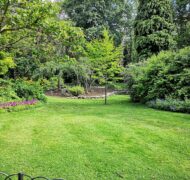Gardening
Book / Produced by partner of TOW
For many people gardening is a favorite pastime. It is not confined to those who have open space around their family homes. Apartment dwellers with small enclosed areas of ground or room for window boxes and indoor plants can also take gardening seriously. Tending other people’s gardens, whether attached to a home, an institution, a shopping mall, a public building or a park, may offer employment. Market gardening often takes the form of a family business. For some people, growing vegetables in the yard is primarily a way of providing food for themselves and their dependents. Others are more interested in growing flowers, shrubs and trees. For some people, as, for example, head gardeners, landscape gardeners and supervisors of botanic gardens, gardening becomes a master trade or profession.
Gardening is an activity that tends to generate passionate commitment. While this is true of any hobby, especially those that are also trades, because of its setting and character gardening gives rise to the kinds of feelings a farmer has for the land. This is not surprising, for gardening is a form of farming in miniature. As such, it is one of the chief ways we in the city have managed to retain continuity between the modern and premodern world. Yet gardening has also given rise to a wide range of clubs, exhibitions, magazines, books, classes and programs that are very much part of contemporary life.
Gardens and Gardening in the Bible
References to gardens go back at least to the second millennium before Christ. In the ancient Near East, cultivation of gardens was widely practiced. Royal families often established large tree-covered parks and nurtured vegetable gardens for the special use of the royal cooks. Even small landholders had their plots and orchards for herbs and fruit trees. Some gardens were famous well beyond their country’s borders, as, for example, the hanging gardens in Babylon.
In the second chapter of the Bible we come across the Garden of Eden. This garden was planted by God: it is God who is described as the one responsible for the trees and their produce (Genesis 2:9-10). And the garden was intended not only for the first man and woman but for God’s own use and pleasure: God is portrayed as “walking in the garden in the cool of the day” (Genesis 3:8). The description of Eden suggests that it was a kind of arboretum, with various species of trees (Ezekiel 31:8) bearing fruit for animals as well as humans (Genesis 1:30) and carrying seed for their future multiplication (Genesis 1:12). There was also a stream watering the Garden (Genesis 2:10). It was the responsibility of the first human pair to “till it and keep it” and to “freely eat” of it (Genesis 2:15, 16 NRSV). In other words, the Garden not only ensured their physical survival and provided natural beauty but was a context for fulfilling their vocation. It was also a place that exhibited the mutual dependence of human beings and the divine creation on one another. It was a complete divine-human-material ecosystem.
References to gardens occur elsewhere in the Bible. Sometimes these belong to ordinary people (Deut. 11:10; 1 Kings 21:1; Luke 13:19), but mostly it is royal gardens or vineyards that are in view (2 Kings 25:4; Neh. 3:15; Eccles. 2:4-6; Jeremiah 39:4; Jeremiah 52:7). These were mainly kitchen gardens and grew melons, cucumbers, onions, leeks, garlics and an array of herbs and aromatic plants. Sometimes sumptuous meals took place in garden settings (Esther 7:7-8), and on occasion young people courted one another there (Song 6:1-3, 11-12). Less well-off people who nevertheless owned some property would have planted less exotic vegetables and trees, such as beans and lentils or fig and almond trees. Even in exile the Israelites were encouraged “to plant gardens and eat what they produce” (Jeremiah 29:5).
Significant events in God’s purposes sometimes happen in gardens, beginning with the fall of the first human pair (Genesis 3:1-7). Idol worship often took place in a garden, perhaps surrounding a shrine (Isaiah 1:29; Isaiah 66:17), and consequently sometimes the prophets pass judgment on the gardens themselves (Amos 4:9). Jesus’ final prayers and arrest took place in a garden (Matthew 26:36-56). In view of what happened in the first garden, many theologians have commented on the divine symmetry involved in the prayers in Gethsemane. Gardens and their produce are also used metaphorically to speak of many other things, for example, of the beauty of a loved one (Song 4:12-5:1), of the coming divine ruler and his kingdom (Isaiah 4:2; Isaiah 11:1-2; Luke 13:18-19), of the integration of the Gentiles into the chosen people, under the new covenant (Romans 11:17-24), and of the Christian’s growth to maturity (Matthew 7:17-20; John 15:2-8; Galatians 5:22; see Spiritual Growth). The coming and character of the kingdom of God is also depicted in terms of a garden (Isaiah 55:12-13; Amos 9:14), sometimes as restoring the Garden of Eden (Isaiah 51:3; Joel 2:3; Joel 3:18; Ezekiel 36:33-36; Ezekiel 47:1-2) with God standing within it (Zech. 14:4, 8). This picture of a celestial “garden city” is most beautifully brought before us in the book of Revelation (Rev. 22:1-2).
Gardening as a Parable of God’s Kingdom
The Bible begins and ends with humankind—and God—in a garden. In the beginning, God comes down to be with the first man and woman, whom he has placed in the Garden of Eden to tend it. In the last chapter of Revelation, the celestial city that God has prepared as an eternal dwelling place of humankind with himself is likened to a garden. In between these two the judgment of God against sin, and the way for the eternal dwelling of man with God, also finds its critical point of resolution in a garden. In the Garden of Gethsemane Jesus, the divine Son come to earth, says yes to the Father’s way of salvation, opening a way of life for all who believe in the Son.
Beyond these critical points in salvation history, we have already seen how the garden functions—metaphorically and otherwise—throughout Scripture. The Christian person can hardly be involved in gardening, whether as a casual pastime or as an intense pursuit, without experiencing gardening as a metaphor, parable or allegory of the kingdom of God and of Christian life in the kingdom of God. In the context of the parable of the sower in the Gospels, we encounter these words of Jesus: “Let anyone with ears to hear listen” (Mark 4:9 NRSV). There is a comparable imperative for a gardener in the present time, arising as the Spirit of God illumines our contemporary experience of the garden: let anyone with eyes see the ways of God with humankind in the whole range of gardening experiences. Some of the more significant experiences in gardening invite our attention.
First, however, it is worthwhile to pass in review elements of the gardening experience. Gardening is an art, and every art has its disciplines, its imperative steps or categories. In light of the fact that the range of “gardens” may vary from African violets in a sunny kitchen window to an extensive garden covering many acres, it is clear that the categories will differ for each gardener. Some important moments in gardening include the decision to have a garden, location of garden, choice of garden type or style (according to personal taste and capability), building the soil foundation with nutrients suited to the plant, choosing from literally thousands of seeds and plants, tilling (deeply!) the soil for young plants, watering, weeding, protecting plants against outer and inner enemies such as birds and parasites, thinning, pruning, harvesting—and celebrating the harvest! Some of these categories have many subheadings. Most categories are featured in the Bible as well as in our contemporary experience of gardening. We choose only eight for brief comment; those that have eyes to see will understand how each of them may be a pointer to the ways of God with and in humankind.
Soil. Although there are exceptions, most gardens flourish and offer the best growth and fruit only when planted in “good” soil. To be sure, the definition of “good” soil varies according to the plant. Although some plants grow in sand and rock and others in clay, they are the exceptions that prove the rule. It is very frustrating to begin the whole gardening process with the wrong soil, soil to which the plant is a stranger, soil which does not support good growth. As a result, the plant will not mature according to its kind. Only when the seed or plant is placed in good soil does it flourish according to its kind. In the parable of the sower, we, the hearers of the Word of God, are likened to the seedbed—whether it be a hardened pathway, rocky ground or good soil (Mark 4:8, 20). The tragedy all about us and in us is that there is such a scarcity of good soil for the planting of God’s seed. “Let anyone with ears to hear listen!”
Planting. After the gardener has chosen the right soil, prepared the seedbed for planting and chosen the right seeds or plants, the all-important work of planting itself begins. This is also an art. One just doesn’t “stick” a plant in the ground (like a stick!) or throw some seed at the seedbed. Planting has to take place at the right time and in the right way. Sometimes there is only a very narrow “window” for planting time. When the time is right, as when frost is past and the warmth of the sun is at hand, seed has to be planted at the correct depth, with the right spacing, and covered carefully and correctly. Then the ground has to be firmed up and watered to hasten the sprouting of the seed and the rooting and establishment of the young plant. Young seedlings have to be tenderly placed in a hole of the right depth and size and firmly set in the soil so that they can quickly root in the good soil. The common expression “tender loving care” has to come into its own in the planting of a garden if there is to be a garden worthy of the name. We who so carefully tend our earthly gardens are called to account again and again in respect to the way we plant the gardens of our lives and the lives of others for whom we are responsible. Paul, the missionary pastor, appears as a forerunner in this respect (1 Cor. 3:6).
Water. No sooner is a seed or plant bedded in the good soil than there is a cry for water. Without water the young plant will wither and die. Watering is again an art. When to water, how to water, and how much to water are all major decisions in sustaining and nurturing the life of a sprouting seed and a growing plant. There must be enough water to penetrate the soil and saturate it with moisture. Care must be taken in applying water to some plants lest they mildew or suffer sunburn. The lack of timely watering in the beginning can be determinative for the whole future life of a plant, resulting in stunted growth and lesser harvests. Strangely enough too much water can also damage, even destroy, a tender young plant or rot a seed. If Paul could present himself as a planter, Apollos was presented as one who watered the Corinthian planting (1 Cor. 3:6). Whether we are planters or waterers of God’s garden, whatever form that may take, we are called to be disciplined artists in our work.
Protection. The tender plant, and the mature plant as well, needs protection. From the moment it leaves the gardener’s hand, the seed or plant is fragile and vulnerable. Whether or not the danger is a bird swooping down, as in the parable of Jesus (Mark 4:4, 15), the seed and the plant are subject to an unending series of inner and outer enemies. The attacks may come in the form of birds, animal intruders, insects, winds, scorching sun, hail, frost and blight—as well as through ourselves. For a dedicated gardener, mistakenly stepping on a tender plant is always an unhappy moment. Some of the enemies attack from without, while others do their evil work within the plant. Stronger and more mature plants fare better before some of these enemies, but all are vulnerable. The Bible is filled with admonitions and warnings to those tending God’s gardens about enemies without and within.
Weeding. Weeding is critical to gardening. Weeds are here understood as intruders in the garden—and weeding is a way of ridding the garden of the intruder. Weeds steal water, light and nutrients from the soil, nourishing themselves and leaving the good planting dwarfed, if not worthless. It seems that weeds never stop coming. In the parable of the sower Jesus uses graphic language to describe the impact of weeds: “the thorns grew up and choked it” (Mark 4:7, 18-19 NRSV). Every gardener understands just how apt the word choked is here! Thus, wherever possible, the imperative is always “weed now.” If weeds are given freedom to flourish, later on one may well destroy a plant as the weed is pulled out (Matthew 13:29). Oddly enough, it seems that there are always new weed enemies to battle in modern gardens. More dangerous are the intruders which intrude into our everyday lives and into our world.
Thinning. Less familiar and less dramatic than planting, watering and weeding, thinning is no less essential for the health of plants and garden as a whole. If, in planting, too many seeds fall in more or less the same spot and all sprout, the net effect can be as fateful as an invasion of weeds. Thus the gardener must, however reluctantly, pluck out the surplus seedlings. If this is not done early, the plants contesting for nutrients, light, water and air will fall short of the standards, becoming stunted and ultimately worthless. Thinning offers a particularly significant parable for modern times, wherein so many lesser things, perhaps good in themselves, vie for our attention, distracting us from the central claim of God on our lives.
Pruning. When Jesus likened himself to a vine and his Father to the vinegrower (John 15:1-12), he placed the urgency of pruning before the church for all time. If thinning is an action in which the gardener needs a certain boldness, then pruning makes even greater demands. It is not easy to put the pruning shear or saw to a vine or tree to which one has long given tender loving care, but holding back can be fatal. Dead wood not only is worthless but can also harbor disease. Old wood needs to be removed to allow expansion room for new branches that will bear fruit (John 15:2). In the grapevine, the goal is to produce grapes, not grapevines—hence the necessity of the pruning knife. The sharpened blade is not nice, but it is necessary.
Harvesting. Some gardens are purely ornamental and do not offer a harvest as such. Here the delight of the gardener is in the resultant color, shape, texture, contrast and natural beauty of a planting. In a fruit or vegetable garden, vineyard or orchard, all the movements of gardening lead up to the harvest—not just the mature, even lovely plant, vine or tree. The good gardener knows what kind of harvest to expect, and when the fruit is ready for picking and eating. The good gardener who has long since planted, nurtured and patiently waited, celebrates the harvest. Every good gardener knows the joy of cutting and presenting a large bouquet of flowers or a basketful of colorful and fragrant fruit. Here the gardener’s forerunner is Jesus, who expresses delight in the lily blossom: “Consider the lilies of the field, how they grow; they neither toil nor spin, yet I tell you, even Solomon in all his glory was not clothed like one of these” (Matthew 6:28-29 NRSV). Those are the words of a person who knew how to gratefully celebrate the harvest. Good gardeners know what they are working for, and they know how to celebrate the results of their labor.
The gardener who has labored and waited, and waited and labored, knows how much of the life and growth of the garden lie outside human hands. The sprouting of the seed, the weather, external conditions, the growing of the tender plant to maturity, blossoming and bearing fruit—these things and much else lie beyond the work and will of the gardener. At the end of the day, gardening is a mystery.
Gardens and Gardening Today
Though the development of tenements in expanding cities from the end of the eighteenth century separated many people from the land, the growth of suburbia from the end of the nineteenth century gave many an opportunity to reconnect with the land in the form of working the small plots around their homes or in public areas. For many such people, the old adage “you can take a person out of a farm but you can’t take the farm out of a person” proved true. Though farming became increasingly restricted to a smaller percentage of the population, suburbia led to the democratizing of gardening, which till then had been a pastime more for the elite than for the ordinary person. In North America the form gardens took was influenced less by the small vegetable plots and orchards around the house typical of farms, or the mixed vegetable and flower beds and shrubs characteristic of the English cottage garden, than by the influence of transcendental naturalists like Henry David Thoreau, with their preference for wide-open spaces and trees. This, and the domination of nature writing by ideas of wilderness rather than cultivation, explains why gardens do not appear much in the poetry and fiction of North American writers, and why nature writings and anthologies do not generally include articles on gardening.
» See also: Farming
» See also: Hobbies
» See also: Leisure
References and Resources
R. Banks, God the Worker: Journeys into the Mind, Heart and Imagination of God (Valley Forge, Penn.: Judson, 1994); H. Crabtree, The Christian Life: Traditional Metaphors and Contemporary Theologies (Cambridge, Mass.: Harvard University Press, 1991); M. Francis and R. T. Hester, eds., The Meaning of Gardens: Idea, Place and Action (Cambridge: MIT Press, 1990); E. Hymans, A History of Gardens and Gardening (London: Dent, 1970); S. C. Juengst, Like a Garden: A Biblical Spirituality of Growth (St. Louis: Westminster/John Knox, 1996); P. Keller, A Gardener Looks at the Fruit of the Spirit (Irving, Tex.: Word, 1986); B. Marranca, ed., American Garden Writing: Gleanings from Garden Lives Then and Now (New York: Penguin, 1988); E. Perenyi, Green Thoughts: A Writer in the Garden (New York: Vintage, 1981).
—Robert Banks and Robert P. Meye





